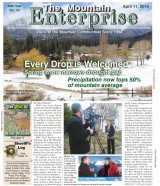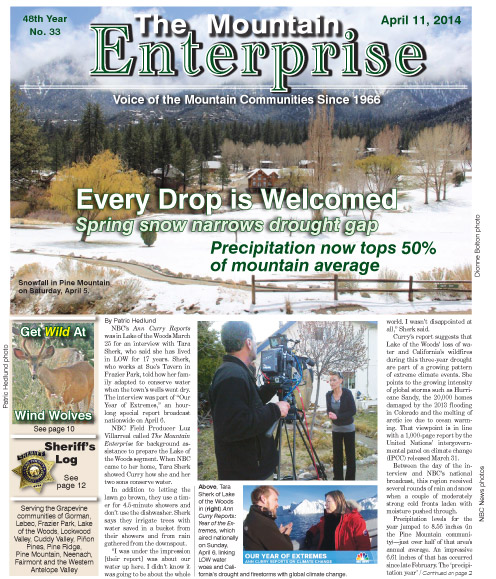Spring snow narrows drought gap
Precipitation now tops 50% of mountain average
By Patric Hedlund
NBC’s Ann Curry Reports was in Lake of the Woods March 25 for an interview with Tara Sherk, who said she has lived in LOW for 17 years. Sherk, who works at Sue’s Tavern in Frazier Park, told how her family adapted to conserve water when the town’s wells went dry. The interview was part of “Our Year of Extremes,” an hour-long special report broadcast nationwide on April 6.
NBC Field Producer Luz Villarreal called The Mountain Enterprise for background assistance to prepare the Lake of the Woods segment. When NBC came to her home, Tara Sherk showed Curry how she and her two sons conserve water.
In addition to letting the lawn go brown, they use a timer for 4.5-minute showers and don’t use the dishwasher. Sherk says they irrigate trees with water saved in a bucket from their showers and from rain gathered from the downspout.
“I was under the impression [their report] was about our water up here. I didn’t know it was going to be about the whole world. I wasn’t disappointed at all,” Sherk said.
Curry’s report suggests that Lake of the Woods’ loss of water and California’s wildfires during this three-year drought are part of a growing pattern of extreme climate events. She points to the growing intensity of global storms such as Hurricane Sandy, the 20,000 homes damaged by the 2013 flooding in Colorado and the melting of arctic ice due to ocean warming. That viewpoint is in line with a 1,000-page report by the United Nations’ intergovernmental panel on climate change (IPCC) released March 31.
Between the day of the interview and NBC’s national broadcast, this region received several rounds of rain and snow when a couple of moderately strong cold fronts laden with moisture pushed through.
Precipitation levels for the year jumped to 8.56 inches (in the Pine Mountain community)—just over half of that area’s annual average. An impressive 6.61 inches of that has occurred since late February. The ‘precipitation year’ (July through June) average is 16.2 inches, according to data compiled by Jerry Ferris for his Pine Mountain Club Weather Station.
This is an area of many microclimates. Lebec and Pine Mountain typically receive more rain than Frazier Park and Lake of the Woods. Readings between weather stations in Lake of the Woods and Frazier Park show roughly 5.99 inches in precipitation for these regions as of this week—2.56 inches less than in Pine Mountain.
Meanwhile, Lake of the Woods Mutual Water Company, after drilling three dry test holes for new water sources last year, will next try working with Frazier Park Public Utility District and a hydrologist to search for additional well locations where healthy drinking water may be found.
LOWMWC has purchased water from Lebec and Frazier Park to keep its tanks full for firefighting. LOW received a $250,000 emergency grant from the state to help it meet the crisis. The district does not meter its customers’ water use, but is beginning to address that issue in its board meetings as a goal. All water districts in the area are emphasizing the importance of conservation.
Preliminary talks are being held about the possibility of LOW and Frazier Park possibly merging into a unified district to attract more state and federal funding to improve the water systems in both areas.
Photo captions
Tara Sherk of Lake of the Woods in (right) Ann Curry Reports: Year of the Extremes, which aired nationally
on Sunday, April 6, linking LOW water woes and California’s drought and firestorms with global climate change.
The Bolton family was out in the snow last weekend to enjoy it while it lasted. Within 24 hours, most of this was melted. About 8.56 inches of precipitation has been received in Pine Mountain community, just over half of the 16.2-inch historical average for the area.
Doug Peters is a professional resource manager and data wonk, who compiled and interpreted the graph shown at top, above. In 2007 he lived in Lake of the Woods. He supervised a UC agricultural center and now works with the U.S. Forest Service.
This historical data shows precipitation since 1949 in Lebec—roughly representative of the Mountain Communities as a whole. This chart shows that the most predictable aspect of precipitation here is its variability. Often several very dry years are followed by a very wet year, followed by return of drought, as shown in this 1948-2007 chart.
To see full stories with photos, please go to The Mountain Enterprise e-Edition
(login required)
You can have your newspaper delivered via mail and include internet access! Just call 661-245-3794.
Also, this story and others are available right now at newsstands throughout the Mountain Communities.
This is part of the April 11, 2014 online edition of The Mountain Enterprise.
Have an opinion on this matter? We'd like to hear from you.

![Tara Sherk of Lake of the Woods in (right) Ann Curry Reports: Year of the Extremes, which aired nationally on Sunday, April 6, linking LOW water woes and California’s drought and firestorms with global climate change. [NBC photo]](https://mountainenterprise.com/wp-content/uploads/TaraSherkLOW_cmyk-324x243.jpg)

